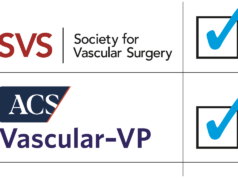 Just 1% of vascular surgeons receive “an inordinate amount” of the total Medicare payments that flow toward the specialty, with disproportionate use of outpatient atherectomy among a small number of providers raising concerns on appropriateness and overutilization, an investigation of provider utilization data discovered.
Just 1% of vascular surgeons receive “an inordinate amount” of the total Medicare payments that flow toward the specialty, with disproportionate use of outpatient atherectomy among a small number of providers raising concerns on appropriateness and overutilization, an investigation of provider utilization data discovered.
Those were among the findings of a study, entitled “Practice patterns of vascular surgery’s ‘1%,’” carried out by William W. Sheaffer, MD, a fellow in the division of vascular surgery at Mayo Clinic Arizona, Phoenix, and colleagues that was published in the January issue of the Annals of Vascular Surgery.
The backdrop to their work is stark.
“Variation in healthcare utilization is an established driver of healthcare costs,” the team of researchers—which is headed up by Mayo Clinic Arizona vascular surgery chair Andrew J. Meltzer, MD—point out. “Recent publications in the lay media and medical literature have identified tremendous variation in treatment intensity and costs. Cardiovascular procedures, some which are disproportionately reimbursed, have received attention from mainstream media outlets including the New York Times and Wall Street Journal.”
The team plumbed the 2016 Medicare Physician Utilization Data File to identify all services and payments to vascular surgeons for commonly performed services among beneficiaries of Medicare. Payments uncovered for these commonly performed services were then placed into “arbitrary” categories such as dialysis access, endovascular, inpatient evaluation and management, outpatient evaluation and management, and noninvasive vascular laboratory, the authors note.
Among all surgeons, the top 1% of earners (31 surgeons) was unspooled based on total payments received during 2016, with a comparative analysis of practice patterns carried out. “Special attention was paid to specific endovascular interventions,” Sheaffer et al write.
The investigators created subcategories of aortic, lower extremity, upper extremity, venous and other. Lower-extremity interventions were categorized by the anatomic site as well as specific procedure: That is to say, atherectomy versus percutaneous transluminal angioplasty (PTA) and stent. Highly reimbursed and frequently performed procedures among the 1% were further analyzed and compared with the remaining workforce. Specific data included total procedures performed, location service that was provided, and specific intervention.
Sheaffer and colleagues found that 3,136 surgeons were identified who earned $589 million during the 12-month window for commonly performed vascular surgery services. Among all vascular surgeons, 31—or the 1%— earned $90 million. That equates to 15% of all payments for commonly performed services in 2016, they note. This group of surgeons received mean payments of $3.1 million compared with $271,000 to all vascular surgeons, Sheaffer et al write.
Furthermore, the highest contributions in payments came from endovascular procedures ($225 million, 38%), noninvasive laboratory services ($125 million, 21%), office evaluation and management ($80 million, 14%) and varicose vein procedures ($56 million, 10%). There were statistically significant differences between the 1% and the remaining workforce in proportions of payments for all categories (p<0.001), the researchers discovered. “Specific dramatic differences included endovascular payments (85% vs. 30%), noninvasive laboratory (6% vs. 24%), office evaluation and management (3% vs. 16%), and varicose vein (3% vs. 11%).”
Still further, lower-extremity procedures accounted for the greatest proportion of payments in the endovascular category for the so-called 1%. They added up to 83% of all endovascular payments. The authors again found statistically significant differences for specific levels of interventions between the two groups of surgeons. “Specifically, tibial interventions accounted for 44% of all services and 29% of payments within ‘the 1%’ compared with 27% of services and 20% of payments in the remaining workforce.”
In terms of atherectomy, statistically significant differences were found when comparing the proportion of PTA and stent versus utilization of atherectomy, Sheaffer and colleagues continue. Atherectomy represented a significantly higher proportion of all lower-extremity interventions in the 1% versus the rest of the vascular surgeon workforce (80% vs. 35%, p<0.001) and 93% of payments for all lower-extremity interventions among the former group of providers.
The researchers then illustrate how this boils down in dollar terms: “When evaluating all atherectomy services accounted for in 2016, there were 19,341 services provided nationwide, accounting for $121 million in total payments. The 31 surgeons comprising ‘the 1%’ performed 39% of all these services, accounting for $59.7 million or 49% of all payments for atherectomy.”
The findings draw firm conclusions from the authors.
“This study highlights a significant disconnect between the practice patterns of a small number of vascular surgeons who receive disproportionate payments from Medicare and the remainder of vascular surgeons,” the write. “The top earners in vascular surgery have a primarily outpatient endovascular practice with increased utilization of atherectomy and tibial interventions compared with the remaining workforce. While patient characteristics cannot be accounted for, the dramatic differences in practice patterns raise concern for potential overuse of specific, highly reimbursed services. With this publicly available data, strong consideration needs to be given to provider and societal-level self-regulation to avoid external forces from driving practice patterns within vascular surgery.”
SOURCE: doi.org/10.1016/j.avsg.2020.07.010












